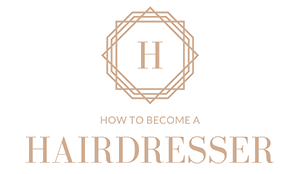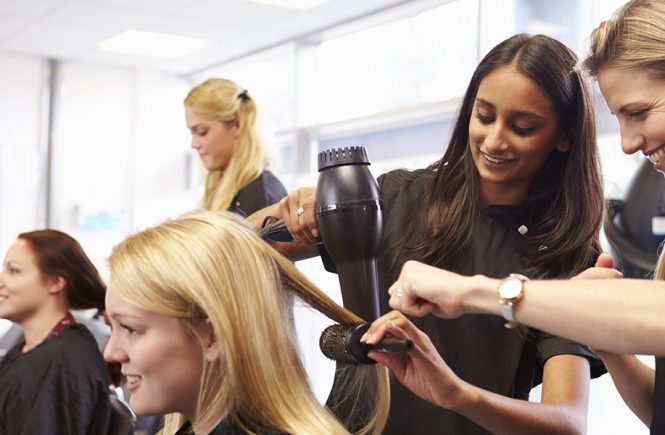Congratulations on taking the first step to find out how to become a hairdresser in Australia and starting your career in Hairdressing!
The Hair and Beauty industry is in high demand and is worth more than $4 billion each year in Australia alone and currently employs around 81,000 people so your chances of getting a job and becoming a Hairdresser are superb!
So what exactly does a hairdresser do?
As a fully qualified hairdresser you can expect to cut, colour, straighten, perm, treat and maintain you clients hair as well as any other request they might have such as blow drying and styling.
However in the early stages of your apprenticeship you will more than likely be undertaking more basic duties such as washing and rinsing hair, welcoming clients, taking bookings, cleaning and maintaining the store and even making a cup of tea for a customer or in some salons bringing them a cheeky glass of bubbly.
Specific duties will vary from salon to salon, to give you a better perspective a list of general requirements is listed below:
- Taking bookings, dairy management and processing payments.
- Offering advice on styling, colouring and maintenance.
- Shampooing, conditioning and treatments.
- Permanently straightening or waving hair.
- Styling your clients with scissors, razors or clippers.
- Braiding, adding hair extensions, weaves and dreadlocks.
- Cut or style weaves or hair pieces.
- Shaving or trimming beards and/or moustaches.
- Keeping your utensils as well as your premises clean and sanitary.
As you advance in your career you will no doubt find your niche and naturally start to specialise in a particular field, for example, becoming a colour specialist, working as a shampoo technician or advancing into the fashion world. But more on that later in the article.
What training do I need?
To become a Hairdresser in Australia you must complete the certificate III in hairdressing. Currently there are two options to complete this course. The first option is to complete an apprenticeship in hairdressing. Hairdressing apprenticeships are one of the most popular apprenticeships with females today with an ever growing increase amongst males.
Entry requirements can vary, but most employers will generally require you to complete year 10 of high school.
Your training will be both on and off the premises. The off premises training is delivered through Registered Training Organisations (RTO’s). Your place of training may depend on the employer and will be finalised as part of your training agreement.
-
- Three to four years apprenticeship.
- Paid work with a “host employer” for the period of the apprenticeship.
- Attending off the premises training at an Registered Training Organisation.
Click here to read more about completing your certificate III as an apprenticeship in hairdressing.
The second option for those is wish to become a hairdresser quickly or within a year is full time study through a Registered Training Organisation (RTO) such as Tafe which is a public institution or through a private establishment. On completion of this course the student with be recognised with a national trade qualification for hairdressing.
Click here to read more about completing your certificate III by studying hairdressing full time or part time.
Ready to take the plunge?
So you know you want to become a hairdresser, you know what’s involved and you are versed in the training requirements. Now it’s time to get boots to the ground and find yourself that dream position.
If you are looking for an an apprenticeship then first things first, get your resume prepared, to read more about preparing your resume click here. Start by chatting to family and friends and put the word out that you are interested in an apprenticeship as a hairdresser, as they say “it’s not what you know, it’s who you know”! Get online, searching for positions on sites such as Seek or Indeed is a sure fire way to find multitudes of salons who are looking to take on an apprentice.
Advance your search by visiting your local beauty salons and introducing yourself, take along your resume and covering letter and introduce yourself to the manager. Explain you are looking for an apprenticeship. Ensure you are well presented as well as portraying a friendly and positive attitude. Remember, if you don’t ask, you don’t get! Another good tip good tip is to visit when the store isn’t too busy!
Once I’m qualified, then what?
As you know you get out what you put in, so once you are qualified and putting in the hard yards the sky’s the limit! From mobile hairdressing to owning your own salon to becoming a celebrity’s private hairstylist, there is no end to where your talents can take you.
Please see our article on building your brand for an in depth review on where your career can take you.
In Summary
Step One: Ensure that you have fully researched and are aware of all the factors involved before committing to a career in hairdressing. Look into how much Australian Hairdressers can earn and what finaicial aid you may be entitled to while studying
Step Two: Certificate III in hairdressing is the course you need to complete to qualify as a hairdresser in Australia. This can be studied over three to four years through an Australian apprenticeship, alternatively you can complete the cert III in around one year via full time study.
Step Three: Advance your career by taking on further study starting with the Certificate IV in hairdressing.





